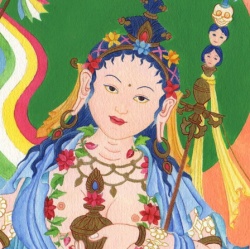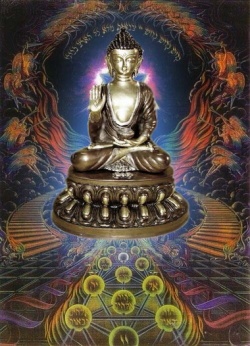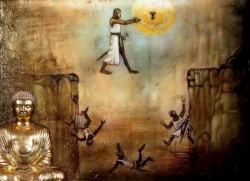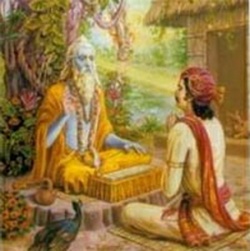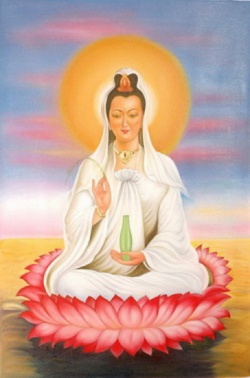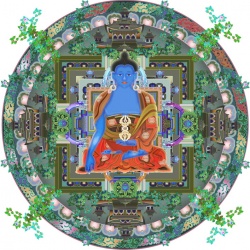The History Of Buddhism - The Early Period
This article describes the early history of Buddhism starting from the death of the Buddha and how the followers of the new faith attempted to preserve the teachings and the memory of the Buddha.
Soon after the Buddha's death, the monks gave up the practice of begging for alms and wandering from place and place. They settled down for a sedentary life in monasteries, built by kings and wealthy merchants who were inspired by the teachings and the events of the Buddha's life and became his ardent followers. With generous donations and material contributions from these patrons, the monasteries thrived as Buddhism took deep roots in the subcontinent, despite stiff competition from sectarian movements within the Vedic religion and other religious movements such as Jainism.
During his life time on earth, the Buddha attracted the attention of many people. His exemplary life, the fact that he descended from a princely family, the simplicity of his teachings and his opposition to ritualism and casteism, drew the attention of many from all ranks and contributed to the immense popularity of Buddhism. The Buddha was aware of the problems of monastic life that could surface within the monastic order over a period of time. He therefore established well defined code of conduct for the monks to ensure that they followed the right way of life during their practice of the Dhamma in general and the eightfold path in particular.
His parinirvana must have left a big vacuum in the Order. None of his followers had his great stature and his personal appeal, though they had an infinite capacity to remain loyal to his teachings and the discipline he established. They were incapable of filling the void he left behind and needed a leading and guiding source of inspiration that would keep them firmly abide by the Buddha, the Dhamma and the Sangha, the three cardinal principles of Buddhism.
The best that they could do in such circumstances was to preserve the teachings of the Buddha in a systematic manner and use them as points of reference in times of doubt and confusion. This would help them preserve his teachings for the future generations, strengthen the roots of Buddhism and create a universal code of conduct that could be implemented uniformly in all the monasteries that were know during that period.
And this was probably one of the objectives of the First Buddhist Council which was convened by the early followers of the Buddha after the Buddha's parinirvana. We understand that soon after the Buddha's parinirvana, his chief disciples, Ananda and Upali recited his teachings to the gathered assembly and thus laid the foundation stone for the Buddhist Canon, that was to emerge later in the form of three Pitikas - Vinaya, Sutta and Abhidhamma.
The Buddha admitted all types of people into the Order, irrespective of their social and religious backgrounds. This practice contributed greatly to the popularity of the religion. But in many respects it also proved to be its weakness, for it admitted into the Order many who were ill qualified for a strict monastic discipline. It helped the Order to grow into an organized body of huge proportions. But at the same time it sowed the seeds of internal dissension and divisions, that finally led to the break up of the Order into various sects and sub-sects.
It is difficult to say how far the immediate disciples and followers of the Buddha succeeded in their efforts to preserve his teachings. The early history of Buddhism does not offer many clues. It is possible that during the life time of the Buddha, his followers might have done some ground work to organize his teachings and preserve them for posterity. True to the ancient Indian tradition, some of the teachings might have been preserved through the oral tradition and in the form of descriptive fables and parables.
We do not know much about the relationship the followers of Buddhism and the Buddha himself maintained during the early days of Buddhism with other religions and faiths. We know that there were occasions in the life of the Buddha when he personally engaged himself in religious debates and discussions with other sects such as the Jainas and the Ajivakas to disprove their theories and beliefs. It is hard to attribute any reason for such debates and discussions on the part of the Buddha, other than unbound compassion the Buddha had towards others and his attempts to bring them to the Dhamma and Sangha in order to help them in their salvation.
The fledgling new faith needed immunity from the corruption of teachings, a strong leadership and a distinct identity of its own to distinguish itself from other religions, gain a strong foothold in the subcontinent, keep the Dhamma and Sangha intact and attract new followers and converts to the faith.
As a scion of a ruling family, and having been tutored in the early part of his life, the Buddha was familiar with the art of leadership, organization and administration. He was also aware of the implications of creating a large body of Buddhist monks who would have to stay together and practice Dhamma under the most challenging circumstances. We know that at times he was disappointed with the behavior and insincerity of some of his followers. He knew the evils of decay and disintegration inherent in all component things, which he reminded his followers to remember even from his death bed.
He therefore organized the Buddhist Monastic Order on the basis of an established code of conduct, a hierarchy with in the Order and a daily and seasonal routine for the community of the monks within the Order. He also maintained a rigid stance when it came to admitting women who he believed would disturb the Order with their very presence and created a procedure to admit them. He exhorted his followers to be wary of the temptations of samsara by remaining focused on the Four Noble Truths and the Eightfold path. He did not designate a successor as he truly believed his followers to be lamps unto themselves and follow the Dhamma as it was taught to them.
One of the new practices that began after his passing away was the veneration of the chaityas or the sacred spots. This practice was already prevalent in ancient India in some rudimentary form and the Buddhists adopted it as their own. Another new practice adopted by The Buddhists was the building of the stupas. Originally stupas were built to designate the places where the ashes of the Buddha were buried as a mark of honor and symbols of veneration. In course of time stupas were being built for other reasons as well such as to express devotion or to honor the relics of a Buddhist monk.The third development was the development of sacred places and objects like the Bodhi tree, the Deer Park etc., which were associated with the Buddha's life and activities. These places became sacred places of pilgrimage and veneration for the followers of Buddhism.
These new developments contributed to the popularity of Buddhism outside the monastic order. But rituals were still looked with disfavor and the worship of the Buddha or his images, perhaps, did not yet begin.
These changes gradually led to the emergence of a new schools of Buddhism that were radically different in several respects from the original teachings of the Buddha. The changes helped the new religion adapt itself to the growing demands of a wider population and helped it emerge as a major world religion.
By the time Asoka became the emperor, Buddhism was already a well established religion in several parts of the Indian subcontinent, competing vigorously with other religious movements, especially the dominant Brahminical religion with its roots deep in several parts of the subcontinent, and the nascent Jainism that was competing for supremacy in certain pockets of the country having secured the support of eminent personalities like Chandragupta Maurya and the royal patronage of the kings of Orissa in the east.
Asoka began his career in a controversial manner. We do not have detailed accounts of his ealry life, but it seems his accession to the throne was not smooth. According to traditional accounts, he had to wage a war of succession against his own brothers for nearly four years and kill them all before ascending the throne. During the early part of his reign he led several campaigns either to suppress rebellions or expand his empire. He established friendly relations with foreign powers but maintained a policy of conquest within the subcontinent.
The Kalinga war brought a radical change in his thinking and approach heralded an era of peace within the subcontinent. He became convinced about the evils of war and converted to the path of Buddhism and the philosophy of non-violence. His direct involvement with Buddhism, led to the expansion of Buddhism on unprecedented scale to the far corners of India and the outside world.
Available evidence suggest that although he was converted to Buddhism, he maintained a very tolerant attitude towards other faiths and treated his subjects fairly irrespective of their religious beliefs. He preached and propagated a form of Dhamma or the law of piety in his empire which was partly Buddhist, partly Brahmnical and partly administrative or empirical in its approach.
While personally following the teachings of the Buddha and spending time in the company of the Buddhist monks, Asoka maintained a very tolerant attitude towards other religions. Despite his interest in the Buddhist way of life, he did not abdicate his responsibilities as the emperor. His inscriptions suggest that he worked relentlessly for the welfare of the people whom he considered as his children. He gave them generous donations and allowed them to preach and practice their respective religions in his empire. He also gave donations for building cave dwellings for a religious sect named Ajivakas.
Although he propagated his law of piety with the flavor of Buddhism, he called himself devanampriya or the beloved of the gods. In many ways his law of piety was above sectarian approach. It represented his effort to resolve the social, moral and religious issues of his time in a secular manner without adding to the religious tension that was already brewing between the orthodox and the the heterodox sections of society. Asokas' Dhamma was more a code of conduct used to inculcate moral discipline and social responsibility among his people than a theological sermon intended to convert them to Buddhism.
However there is little doubt that his commitment to the cause of Buddhism was unquestionable. He gave up vihara yatras or tours of pleasure and instead went on dharma yatras or tours of piety to preach Buddhism. He replaced his policy of political conquest with that of Dhamma Vijaya or the conquest of the Dhamma. He instructed important members of his administration to go on tours and preach the Dhamma to the masses. He got the relics of the Buddha recovered from the earlier stupas and redistributed them at various other places by building several new stupas. He also played a prominent role in convening the third Buddhist Council to resolve several issues concerning Buddhism. Because of his direct patronage, Buddhism became very popular in various parts of India and led to the establishment of several Buddhist centers, especially the places like the present day Andhrapradesh, Maharashtra, Madhyapradesh, Orissa and Karnataka. He dispatched Buddhist missions to various parts of the world, such as present day Afghanistan, Syria, Egypt, Cyrene, Macedonia and Emirus. Within the subcontinent, he sent missionaries to several places. like Kashmir, the Himalayan country, Maharashtra, Varanasi, Mysore and so on.
While we do not know much about the impact his missions to other countries created, his mission to Ceylon was a great success. It contributed directly to the spread of Buddhism in the island country. Because of his efforts, Buddhism was an instant success in Ceylon. According to the Chronicles of Ceylon, Mahendra (Mahinda), who was either a brother or son of Asoka, went to Ceylon, where he converted the king and his 40000 subjects to Buddhism. It was followed by another mission, which was headed by Sanghamitra, who was said to be a daughter of Asoka himself. According to tradition she carried along with her a branch of the original Bodhi tree under which the Buddha got enlightenment and planted it there in the Ceylonese soil. The tree that grew out of the sapling is still there for visitors to see. Sanghamitra converted many female members of the Ceylonese royal family to Buddhism.
Post Mauryan Period
After the death of Asoka, the Mauryan empire declined. But Buddhism grew in strength. The Sungas succeeded the Mauryans in the north. They were staunch supporters of the orthodox Brahmincial religion and revived the vedic practices. Some of them were very hostile to Buddhism. Pushaymitra Sunga, one of the most prominent Sunga rules and hero of the literary work "Malaviakagnimitram", said to have indulged in the religious persecution of Buddhist monks in his empire and rewarded those who persecuted the Buddhist monks.
The Bactrian Greeks who invaded India during this time, brought under their control the whole part of what is now known as Western Pakistan and parts of northern India comprising Malwa, parts of Rajastahn, modern U.P and Bihar. Little is known about their religious and social institutions. Some of them adopted Buddhism and supported it like king Menander who ruled Punjab, with Sakala as his capital and was acclaimed by the Buddhist texts as a great warrior king. The famous Pali Buddhist text, Milindapatha, records his conversations with monk Nagasena.
The Sungas
The Mauryas were succeeded by the Sungas, who ruled large parts of northern India between 185 B.C. and 73 B.C., with Vidisa in eastern Malwa as their capital. The Sungas were avowed followers of Vedic religion and showed little respect for other religions. They promoted Hinduism actively and were intolerant towards Buddhism. According to Buddhist tradition, they made serious attempts to suppress the religion and even indulged in religious persecution. Pushyamitra Sunga, one of the most prominent ruler of the dynasty, was said to be a great persecutor of Buddhism. Apart from patronizing Brahminism at the expense of other faiths, he was referred as a religious bigot who indulged in the destruction of several Buddhist monuments, including a famous monastery at Pataliputra. He said to have even offered monetary reward for killing the Buddhist monks. Some historians do not agree with this theory and point out the construction of the Buddhist stupas and railings at Barhut and the uninterrupted existence of several other stupas and Buddhist monuments throughout the kingdom of the Sungas as evidence their religious tolerance.
The Satavahanas
The Satavahanas ruled large parts of Andhrapradesh, Maharashtra and central India between 200 BC and 250 AD. Like the Sungas they were Brahmin rulers, but unlike the former, displayed exemplary tolerance towards other religions. Both Buddhism and Hinduism flourished and coexisted peacefully during their reign. They made generous grants for the construction and maintenance of several monasteries, cave dwellings and residential quarters for the Buddhist monks. Several Buddhist centers flourished and gained prominence like the ones at Amaravathi and Nagarjunakonda in Andhrapradesh during their period.
The Kushanas - Kanishka
Emperor Kanishka was a Saka-Kushana king. He is remembered in Indian history as a great patron of Buddhism, next to Asoka. He ruled parts of central Asia and north Western India some time during the early Christian era. The fourth Buddhist council was held in Kashmir under his patronage.
During this period, the Mahayana school of Buddhism became popular in the north while Hianayana remained popular in the south and in Ceylon. The Mahayana doctrines crossed the frontiers of the sub-continent and traveled eastwards to China and other far eastern countries.
The Gupta Period
The Guptas ruled large tracts of the Indian subcontinent from the fourth century A.D. to the sixth century A.D. They were great patrons of Vedic religion. Fahien, a Chinese Buddhist monk visited India during the reign of Chandra Gupta II and stayed in India for six years.
His travel account throws considerable light on the socio-religious life in the country during this period. Fahien noted that Buddhism was still popular, though Hinduism was gaining ground under the patronage of the Guptas. He also commented that due to the influence of Buddhism and Jainism many people from higher sections of society had become vegetarians.
The Post Gupta Period
At the close of the fifth century A.D., the Huna began their invasions into India. The Hunas were the most cruel foreign rulers to invade India in ancient times. They were also known for their religious intolerance. Both Hsuan Tsang and the famous Kashmiri poet, Kalhana, recorded the cruel persecution they meted out to Buddhists. Fortunately the Hunas had a short reign in the country and thereby the native religions escaped from a great destruction.
Harshavardhana
In the first decade of seventh century A.D., Harshavardhana ascended the throne at the age of sixteen. He ruled large parts of central and northern India. His reign lasted for about forty one years. He is also known in Indian history as a great patron of Buddhism, and a man of considerable virtues.
Hsuan Tsang, the famous Buddhist scholar from China, visited India during his reign and stayed in his court for seven years. Like Fa-hien, his predecessor, he also recorded his experiences in India in the form of a book. He gave a fairly accurate picture of the conditions prevailing in the country during his several years' stay. He described Nalanda as a great center of learning for Buddhist monks.
Harshavardhana was a follower of Buddhism. But like many other emperor in the recorded history of India, he was tolerant of other religions and also worshipped some Hindu gods. He saved Buddhism from the hands of Sasanka, who was bent upon destroying Buddhist monuments and harassing Buddhist followers. Despite of support from Harhsavardhana, Buddhism was in decline in various parts of the country.
Vajrayana Buddhism
During the early eight century A.D. Vajrayana Buddhism appeared in eastern India. It gained wider acceptance in Bihar and Bengal. The Vikramasila monastery in Bihar was popular center for this new sect, which was partly based upon the ancient Vedic Tantric practices and worship of Mother Goddess. In subsequent times, Tibet and Nepal came under the influence of Vajrayana Buddhism. Sub-sects such as Sahajayana, Kalachakrayana, and Mantrayana soon arose out of this new sect.
Decline
Despite of the support and patronage by Harshavardhana and by Pala kings, who came later, by the end of twelfth century A.D, Buddhism declined as a major religious force in the sub-continent . The growing influence of Bhakti movement and the religious bigotry of the Muslim invaders sealed what ever opportunities it had for revival and renewal. However Buddhism continued to flourish in other parts of the world, especially in China, Korea, Japan, Cambodia, Thailand and other far eastern countries.
Today Buddhism is practised in various parts of the world. In India it has the dubious distinction of a separate religion as well as a movement with in Hinduism. The Hindus consider the Buddha as an incarnation of Lord Vishnu. But the Buddhists disagree. As a religion, except in certain parts like Sikkhim, Ladakh, Buddhism is a minority religion in India.
But in neighboring Nepal, Bhutan and Ceylon it is still very popular religion. Though it greatly disappeared in main land China, it still survives in many far eastern countries and Japan. The west was introduced to Buddhism mainly in the last century. It is presently attracting many new followers from the western world. As a religion and as a way of life, Buddhism has a great religions appeal to the educated and liberal minded people of the west. It has an inherent strength, a certain dignified charm . It will continue to attract many new followers.

